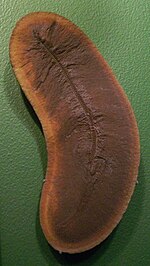| Pseudophlegethontia Temporal range: Late Carboniferous,
| |
|---|---|

| |
| Fossil of P. turnbullorum in the Field Museum of Natural History | |
| Scientific classification | |
| Domain: | Eukaryota |
| Kingdom: | Animalia |
| Phylum: | Chordata |
| Clade: | Sarcopterygii |
| Clade: | Tetrapodomorpha |
| Order: | †Aistopoda |
| Clade: | †Phlegethontioidea |
| Family: | †Pseudophlegethontiidae Anderson, 2003 |
| Genus: | †Pseudophlegethontia Anderson, 2003 |
| Species: | †P. turnbullorum
|
| Binomial name | |
| †Pseudophlegethontia turnbullorum Anderson, 2003
| |
Pseudophlegethontia is an extinct genus of aïstopod tetrapodomorphs. It is the only member of the family Pseudophlegethontiidae. The only species is the type species P. turnbullorum, named in 2003. Fossils of Pseudophlegethontia have been found from the Mazon Creek fossil beds in Grundy County, Illinois, a conservation lagerstätte well known for the exceptional preservation of middle Pennsylvanian taxa.[1]
Pseudophlegethontia has been considered to be morphologically intermediate between derived phlegethontiids and more basal "ophiderpetontids" such as Ophiderpeton. It possesses basal characters such as a relatively short body, "k shaped" ribs, and distinctive skull roof bones while also possessing several more derived features such as a pointed snout, thin gastralia, and a lack of dorsal osteoderms.[1] It is usually,[2][3] but not unanimously,[4] placed as the sister taxon to phlegethontiids, represented by Phlegethontia.
References
[edit]- ^ a b Anderson, J. S. (2003). "A new aïstopod (Tetrapoda:Lepospondyli) from Mazon Creek, Illinois". Journal of Vertebrate Paleontology. 23 (1): 79–88. doi:10.1671/0272-4634(2003)23[79:anatlf]2.0.co;2. S2CID 85104000.
- ^ Ruta, Marcello; Jeffery, Jonathan E.; Coates, Michael I. (2003-12-07). "A supertree of early tetrapods". Proceedings of the Royal Society of London. Series B: Biological Sciences. 270 (1532): 2507–2516. doi:10.1098/rspb.2003.2524. PMC 1691537. PMID 14667343.
- ^ Anderson, Jason S.; Carroll, Robert L.; Rowe, Timothy B. (2003). "New information on Lethiscus stocki (Tetrapoda: Lepospondyli: Aistopoda) from high-resolution computed tomography and a phylogenetic analysis of Aistopoda" (PDF). Canadian Journal of Earth Sciences. 40 (8): 1071–1083. Bibcode:2003CaJES..40.1071A. doi:10.1139/e03-023.
- ^ Marjanović, David; Laurin, Michel (2019-01-04). "Phylogeny of Paleozoic limbed vertebrates reassessed through revision and expansion of the largest published relevant data matrix". PeerJ. 6: e5565. doi:10.7717/peerj.5565. ISSN 2167-8359. PMC 6322490. PMID 30631641.





